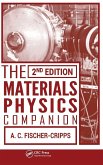R. Pauncz
The Symmetric Group in Quantum Chemistry
R. Pauncz
The Symmetric Group in Quantum Chemistry
- Gebundenes Buch
- Merkliste
- Auf die Merkliste
- Bewerten Bewerten
- Teilen
- Produkt teilen
- Produkterinnerung
- Produkterinnerung
The first book to provide comprehensive treatment of the use of the symmetric group in quantum chemical structures of atoms, molecules, and solids. It covers the conventional Slater determinant approach, the construction of spin eigenfunctions, spin-free quantum chemistry, the unitary group approach, and the spin-coupled valence bond method.
Andere Kunden interessierten sich auch für
![The Science of Defoaming The Science of Defoaming]() Peter R. GarrettThe Science of Defoaming325,99 €
Peter R. GarrettThe Science of Defoaming325,99 €![Quantum Dynamics Quantum Dynamics]() Eric R. BittnerQuantum Dynamics218,99 €
Eric R. BittnerQuantum Dynamics218,99 €![The Materials Physics Companion The Materials Physics Companion]() Anthony C. Fischer-CrippsThe Materials Physics Companion230,99 €
Anthony C. Fischer-CrippsThe Materials Physics Companion230,99 €![The Balanced Engineer The Balanced Engineer]() IeeeThe Balanced Engineer89,99 €
IeeeThe Balanced Engineer89,99 €![Accurate Condensed-Phase Quantum Chemistry Accurate Condensed-Phase Quantum Chemistry]() Accurate Condensed-Phase Quantum Chemistry168,99 €
Accurate Condensed-Phase Quantum Chemistry168,99 €![The Preparation of Dispersions in Liquids The Preparation of Dispersions in Liquids]() H. N. SteinThe Preparation of Dispersions in Liquids323,99 €
H. N. SteinThe Preparation of Dispersions in Liquids323,99 €![The Molecular Theory of Adsorption in Porous Solids The Molecular Theory of Adsorption in Porous Solids]() Yu. K. TovbinThe Molecular Theory of Adsorption in Porous Solids271,99 €
Yu. K. TovbinThe Molecular Theory of Adsorption in Porous Solids271,99 €-
-
-
The first book to provide comprehensive treatment of the use of the symmetric group in quantum chemical structures of atoms, molecules, and solids. It covers the conventional Slater determinant approach, the construction of spin eigenfunctions, spin-free quantum chemistry, the unitary group approach, and the spin-coupled valence bond method.
Produktdetails
- Produktdetails
- Verlag: CRC Press
- Seitenzahl: 344
- Erscheinungstermin: 8. Dezember 2017
- Englisch
- Abmessung: 240mm x 161mm x 23mm
- Gewicht: 681g
- ISBN-13: 9781315898124
- ISBN-10: 1315898128
- Artikelnr.: 50854985
- Herstellerkennzeichnung
- Libri GmbH
- Europaallee 1
- 36244 Bad Hersfeld
- gpsr@libri.de
- Verlag: CRC Press
- Seitenzahl: 344
- Erscheinungstermin: 8. Dezember 2017
- Englisch
- Abmessung: 240mm x 161mm x 23mm
- Gewicht: 681g
- ISBN-13: 9781315898124
- ISBN-10: 1315898128
- Artikelnr.: 50854985
- Herstellerkennzeichnung
- Libri GmbH
- Europaallee 1
- 36244 Bad Hersfeld
- gpsr@libri.de
R. Pauncz
1. The Quantum Mechanical Background: Introduction 2. Spin-free Hamiltonian
3. The Antisymmetry Principle 4. Atomic and Molecular Orbitals 5. Slater
Determinant 6. The Self-consistent-field Method 7. Configuration
Interaction Method 8. Slater-Condon Rules 9. L wdin Rules 10. The Symmetric
Group: Introduction 11. Permutations 12. The Symmetric Group 13. Cyclic
Permutation 14. Classes of the Symmetric Group 15. Subgroups of the
Symmetric Group 16. Double Cosets 17. Representation of SN: Reps of the
Symmetric Group 18. Young Tableaux 19. Young's Orthogonal Representation
20. The Branching Law of the Symmetric Group 21. The Conjugate
Representation 22. The Coset Representation 23. Decomposition of the Coset
Representation 24. Characters of the Symmetric Group 25. Calculation of the
Characters 26. The Subgroup S2 S2... S2 27. The Symmetric Group Algebra:
Algebraic Notions. Class Operators 28. Matric Basis of the Group Algebra
29. Matric Basis for the Centrum of the Algebra 30. The Young Operator
Basis 31. Spin Eigenfunctions: Introduction 32. Construction of Spin
Eigenfunctions 33. The Genealogical Construction 34. The Branching Diagram
35. Reps of the SN Generated by the Spin Fns 36. Yamanouchi-Kotani Method
for the Reps 37. Branching the Diagram Fns and Young Tableaux 38. Serber
Spin Functions 39. Projected Spin Eigenfunctions 40. Spin-paired Spin
Eigenfunctions 41. Spatial Functions: Antisymmetric Wavefunction 42.
Decomposition of the Wavefunction 43. Reps of SN by the Spatial Functions
44. Branching Diagram Functions 45. Serber Wavefunction 46. Projected
Wavefunction 47. Valence Bond Wavefunction 48. Spin Free Quantum Chemistry:
Introduction 49. Orbital Product Functions 50. Invariance Group of the
Primitive Ket 51. Spin-Free Exclusion Principle 52. Structure Projections
53. Spin-free Counterpart of AFVSk 54. Spin-free Counterpart of the
Projected Fn 55. Gallup's Tableau Operators 56. Calculation of the Pauling
Numbers 57. Li's Algorithm 58. Unitary Group Approach: Introduction 59.
Basic Notions 60. Tensor Space 61. Model Hamiltonian 62. Reps of the
Unitary Group 63. The Branching Law of the Unitary Group 64. Representation
Matrices
3. The Antisymmetry Principle 4. Atomic and Molecular Orbitals 5. Slater
Determinant 6. The Self-consistent-field Method 7. Configuration
Interaction Method 8. Slater-Condon Rules 9. L wdin Rules 10. The Symmetric
Group: Introduction 11. Permutations 12. The Symmetric Group 13. Cyclic
Permutation 14. Classes of the Symmetric Group 15. Subgroups of the
Symmetric Group 16. Double Cosets 17. Representation of SN: Reps of the
Symmetric Group 18. Young Tableaux 19. Young's Orthogonal Representation
20. The Branching Law of the Symmetric Group 21. The Conjugate
Representation 22. The Coset Representation 23. Decomposition of the Coset
Representation 24. Characters of the Symmetric Group 25. Calculation of the
Characters 26. The Subgroup S2 S2... S2 27. The Symmetric Group Algebra:
Algebraic Notions. Class Operators 28. Matric Basis of the Group Algebra
29. Matric Basis for the Centrum of the Algebra 30. The Young Operator
Basis 31. Spin Eigenfunctions: Introduction 32. Construction of Spin
Eigenfunctions 33. The Genealogical Construction 34. The Branching Diagram
35. Reps of the SN Generated by the Spin Fns 36. Yamanouchi-Kotani Method
for the Reps 37. Branching the Diagram Fns and Young Tableaux 38. Serber
Spin Functions 39. Projected Spin Eigenfunctions 40. Spin-paired Spin
Eigenfunctions 41. Spatial Functions: Antisymmetric Wavefunction 42.
Decomposition of the Wavefunction 43. Reps of SN by the Spatial Functions
44. Branching Diagram Functions 45. Serber Wavefunction 46. Projected
Wavefunction 47. Valence Bond Wavefunction 48. Spin Free Quantum Chemistry:
Introduction 49. Orbital Product Functions 50. Invariance Group of the
Primitive Ket 51. Spin-Free Exclusion Principle 52. Structure Projections
53. Spin-free Counterpart of AFVSk 54. Spin-free Counterpart of the
Projected Fn 55. Gallup's Tableau Operators 56. Calculation of the Pauling
Numbers 57. Li's Algorithm 58. Unitary Group Approach: Introduction 59.
Basic Notions 60. Tensor Space 61. Model Hamiltonian 62. Reps of the
Unitary Group 63. The Branching Law of the Unitary Group 64. Representation
Matrices
1. The Quantum Mechanical Background: Introduction 2. Spin-free Hamiltonian
3. The Antisymmetry Principle 4. Atomic and Molecular Orbitals 5. Slater
Determinant 6. The Self-consistent-field Method 7. Configuration
Interaction Method 8. Slater-Condon Rules 9. L wdin Rules 10. The Symmetric
Group: Introduction 11. Permutations 12. The Symmetric Group 13. Cyclic
Permutation 14. Classes of the Symmetric Group 15. Subgroups of the
Symmetric Group 16. Double Cosets 17. Representation of SN: Reps of the
Symmetric Group 18. Young Tableaux 19. Young's Orthogonal Representation
20. The Branching Law of the Symmetric Group 21. The Conjugate
Representation 22. The Coset Representation 23. Decomposition of the Coset
Representation 24. Characters of the Symmetric Group 25. Calculation of the
Characters 26. The Subgroup S2 S2... S2 27. The Symmetric Group Algebra:
Algebraic Notions. Class Operators 28. Matric Basis of the Group Algebra
29. Matric Basis for the Centrum of the Algebra 30. The Young Operator
Basis 31. Spin Eigenfunctions: Introduction 32. Construction of Spin
Eigenfunctions 33. The Genealogical Construction 34. The Branching Diagram
35. Reps of the SN Generated by the Spin Fns 36. Yamanouchi-Kotani Method
for the Reps 37. Branching the Diagram Fns and Young Tableaux 38. Serber
Spin Functions 39. Projected Spin Eigenfunctions 40. Spin-paired Spin
Eigenfunctions 41. Spatial Functions: Antisymmetric Wavefunction 42.
Decomposition of the Wavefunction 43. Reps of SN by the Spatial Functions
44. Branching Diagram Functions 45. Serber Wavefunction 46. Projected
Wavefunction 47. Valence Bond Wavefunction 48. Spin Free Quantum Chemistry:
Introduction 49. Orbital Product Functions 50. Invariance Group of the
Primitive Ket 51. Spin-Free Exclusion Principle 52. Structure Projections
53. Spin-free Counterpart of AFVSk 54. Spin-free Counterpart of the
Projected Fn 55. Gallup's Tableau Operators 56. Calculation of the Pauling
Numbers 57. Li's Algorithm 58. Unitary Group Approach: Introduction 59.
Basic Notions 60. Tensor Space 61. Model Hamiltonian 62. Reps of the
Unitary Group 63. The Branching Law of the Unitary Group 64. Representation
Matrices
3. The Antisymmetry Principle 4. Atomic and Molecular Orbitals 5. Slater
Determinant 6. The Self-consistent-field Method 7. Configuration
Interaction Method 8. Slater-Condon Rules 9. L wdin Rules 10. The Symmetric
Group: Introduction 11. Permutations 12. The Symmetric Group 13. Cyclic
Permutation 14. Classes of the Symmetric Group 15. Subgroups of the
Symmetric Group 16. Double Cosets 17. Representation of SN: Reps of the
Symmetric Group 18. Young Tableaux 19. Young's Orthogonal Representation
20. The Branching Law of the Symmetric Group 21. The Conjugate
Representation 22. The Coset Representation 23. Decomposition of the Coset
Representation 24. Characters of the Symmetric Group 25. Calculation of the
Characters 26. The Subgroup S2 S2... S2 27. The Symmetric Group Algebra:
Algebraic Notions. Class Operators 28. Matric Basis of the Group Algebra
29. Matric Basis for the Centrum of the Algebra 30. The Young Operator
Basis 31. Spin Eigenfunctions: Introduction 32. Construction of Spin
Eigenfunctions 33. The Genealogical Construction 34. The Branching Diagram
35. Reps of the SN Generated by the Spin Fns 36. Yamanouchi-Kotani Method
for the Reps 37. Branching the Diagram Fns and Young Tableaux 38. Serber
Spin Functions 39. Projected Spin Eigenfunctions 40. Spin-paired Spin
Eigenfunctions 41. Spatial Functions: Antisymmetric Wavefunction 42.
Decomposition of the Wavefunction 43. Reps of SN by the Spatial Functions
44. Branching Diagram Functions 45. Serber Wavefunction 46. Projected
Wavefunction 47. Valence Bond Wavefunction 48. Spin Free Quantum Chemistry:
Introduction 49. Orbital Product Functions 50. Invariance Group of the
Primitive Ket 51. Spin-Free Exclusion Principle 52. Structure Projections
53. Spin-free Counterpart of AFVSk 54. Spin-free Counterpart of the
Projected Fn 55. Gallup's Tableau Operators 56. Calculation of the Pauling
Numbers 57. Li's Algorithm 58. Unitary Group Approach: Introduction 59.
Basic Notions 60. Tensor Space 61. Model Hamiltonian 62. Reps of the
Unitary Group 63. The Branching Law of the Unitary Group 64. Representation
Matrices








